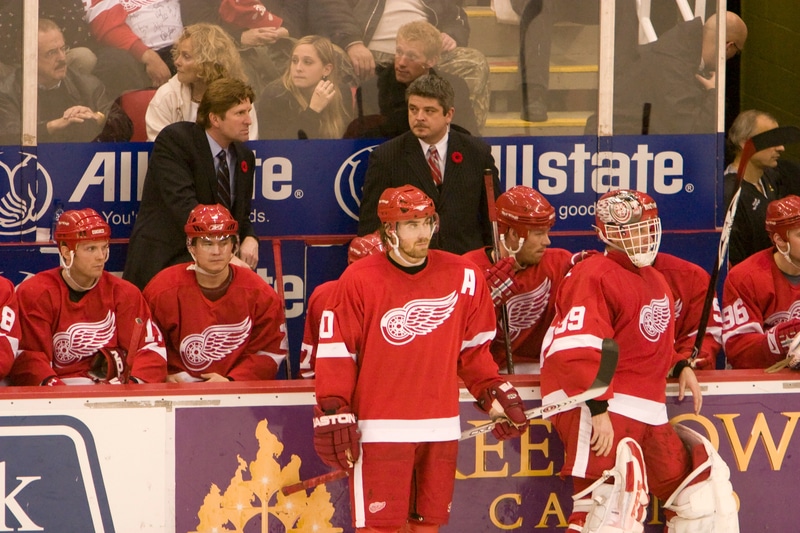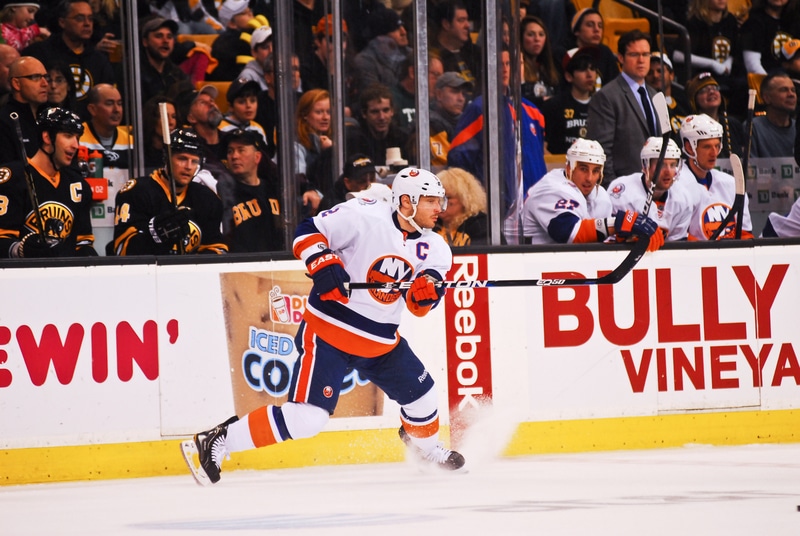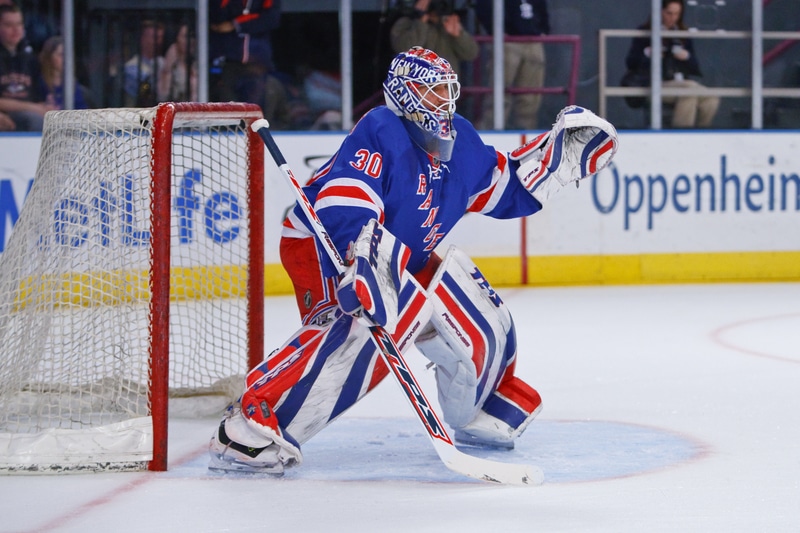Last updated on November 3rd, 2023 at 03:29 pm
Line changes (substitutions) in hockey can occur during live play and stoppage action. Any player on the ice can swap for a substitute on the bench so long as they are within 5 feet of the team bench. The new player on the ice can’t touch the puck until the player they are switching with is entirely off the ice.
So, how many substitutions are you allowed in hockey? What is a line change in hockey? How do NHL players know when to substitute during a game? Why do hockey players sub so much, and when should substitutions occur during a game? Can a team substitute the goalie? Finally, what happens if there are too many players on the ice?
Here is a complete guide to substitutions in hockey.
How Many Substitutions are you Allowed in hockey?
In short, there is no limit to the number of substitutions (line changes) allowed in hockey. Players can come on and off the ice as much as they like during live play and stoppages. The only exceptions when you can’t make substitutions are when there are too many men on the ice during live play. The other reason is stoppage due to an icing violation.
In the case of an icing violation, the team which committed the violation can’t make any substitutions. An icing violation occurs when one team shoots the puck from their half of the center ice line down past the other team’s goal line without touching it or allowing the opponent to play the puck.
How Do NHL Players Know When to Sub?
NHL players know when to sub by listening to their coaches. In general, the coach in an ice hockey game will detail the lines in hockey before the game starts. Each player will know their position (center, left-wing, right-wing, left defenseman, or right defenseman) and who else is on their line for the game.
During the game, a coach will indicate to players which line is next to go onto the ice. It is then the player on the bench’s job to monitor the player currently playing at their position on the ice. When that position player comes over to the bench for a substitution, they must be ready to hop over the boards and onto the ice quickly.
A coach may make last-minute adjustments during a stoppage and conduct a line change. Also, during intermissions between periods, the coach tends to go over line change formations and more if they want to change it.
Why Do Hockey Players Sub So Much?
Hockey players sub so much because the sport is extremely physically exhausting. Unlike other sports such as baseball, soccer, football, or basketball, ice hockey players make substitutions every 1 or 2 minutes of ice time, sometimes even shorter. Ice skating is exceptionally physically demanding, and in most cases, players’ legs will start to give out after just a couple of minutes.
It is essential to make substitutions quickly in hockey because teams want to avoid being caught in a spot where their players are tired and stuck on the ice in the defensive zone. Other teams will look to take advantage of tired opposing legs as it makes controlling the puck and generating scoring chances significantly easier.
By making quick and timely substitutions and line changes, teams can better avoid the risks that come from fatigue.
When Should Hockey Teams Make Substitutions / Line Changes?
One time that teams make substitutions is in the event of a stoppage play before the upcoming face-off. During a stoppage in play, the visiting team must make their substitutions first if they want to make any changes. The home team is then allowed to make substitutions after. Allowing the visiting squad to sub first gives the home team an advantage, as they can play matchups.
For example, if the away team substitutes their fourth line onto the ice for a face-off, the home team might match up by putting their fourth line on the ice. Or, if the away team puts its best offensive line on the ice, the home team can match up during the stoppage with its best defensive line.
Another instance in which teams should look to make substitutions is following a dump-in. A dump-in occurs when one team shoots the puck from the neutral zone into the opposing team’s defensive zone. Dump-ins give the tired skaters on the ice an opportunity to come off for a substitution without risking the chance of a goal-scoring opportunity against them.
Can a Hockey Team Substitute the Goalie?
A team can substitute their goalie in a couple of different ways. Firstly, a team may substitute their starting goalie for a replacement goalie. A goalie change will usually only occur in the event of an injury or if the starting goaltender struggles significantly within the first couple of periods.
The second option for substituting a goalie enables the team to bring an extra skater onto the ice. Substituting a goalie for a skater is extremely risky, as it leaves your team with an empty net. Substituting a goalie for a skater is only done in the event of a penalty against the other team or desperation with little time left on the clock. Replacing the goalie with a skater is known as pulling the goalie. It gives the team a pseudo powerplay as they get a six vs. five skater advantage.
What Happens if There are Too Many Players on the Ice?
In the case of too many men on the ice, the referee will give the team a minor penalty. The team that commits this minor penalty will have a player sent to the penalty box for two minutes and must play four vs. five for the penalty duration. When this occurs during a game, it is a penalty-kill moment.
Conclusion:
In conclusion, hockey substitutions can occur during a stoppage or live play. Typically, substitutions or line changes will occur every minute or two, and usually, these changes are from the coaching staff. Hockey substitution frequently occurs because teams don’t want skaters tired on the ice playing the game.
In general, hockey teams will look to sub during stoppages before a face-off or following a dump-in during live play. During a stoppage, the home team can make line changes last, allowing them to match up with the away team at their discretion. In the event of too many players on the ice, the team committing the violation receives a minor penalty.
Goalies can be swapped for a backup or substituted for an extra skater if needed. Swapping for an extra skater leaves the net empty and should only be done in the case of an emergency or a delayed powerplay chance.
Similar Posts:
How Long is a Hockey Intermission?
What is the Frozen Four in Hockey?
What is a Power Play in Hockey?
What is a Penalty Shot in Hockey?
Greg Kristan, owner of The Stadium Reviews, LLC and TM Blast, LLC, brings his extensive experience visiting over half of the MLB ballparks, along with numerous MLS, NHL, NBA, and NFL venues, to provide in-depth coverage on the bag policy, food options, and parking. He has also been interviewed about his experiences on several sports podcasts.







